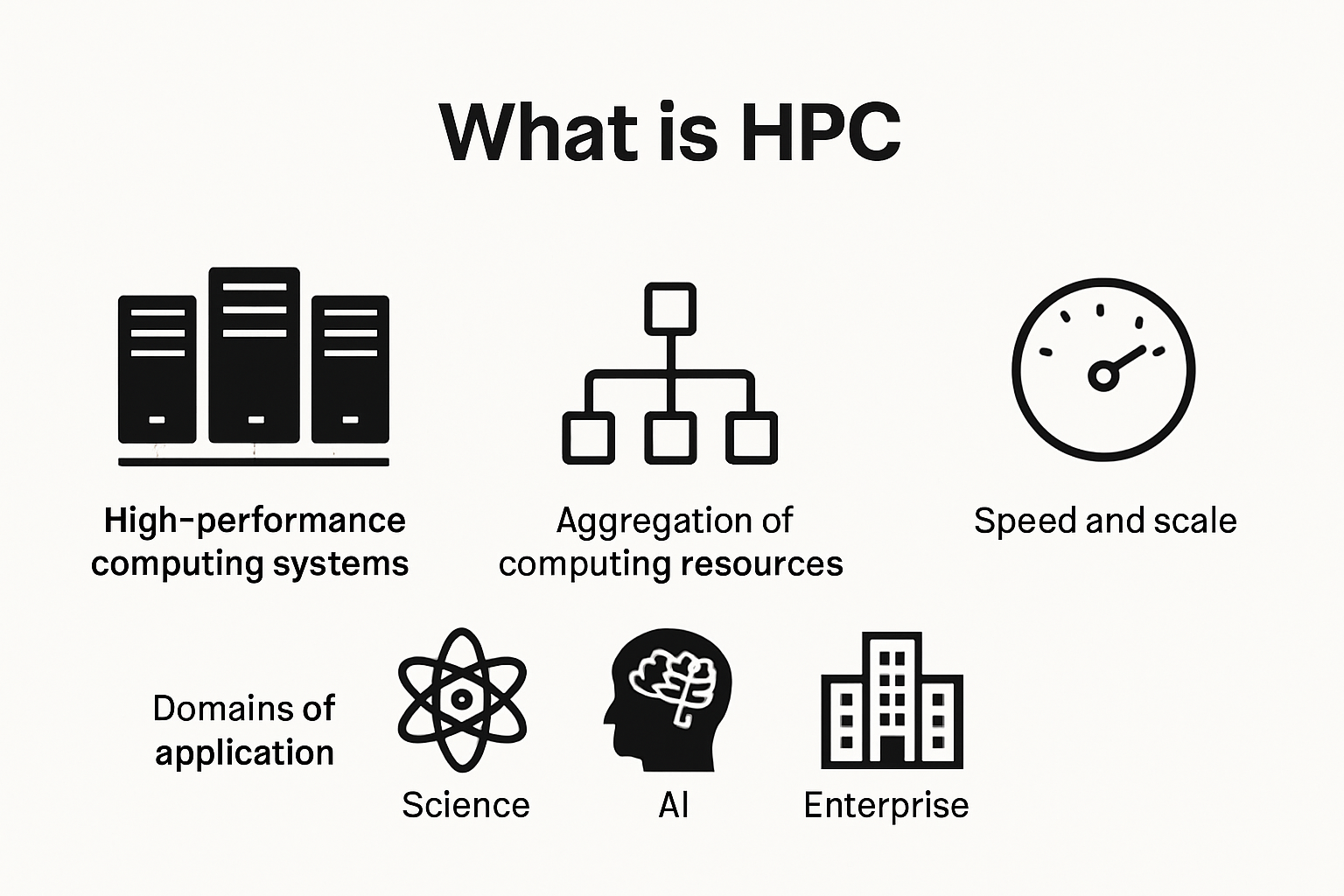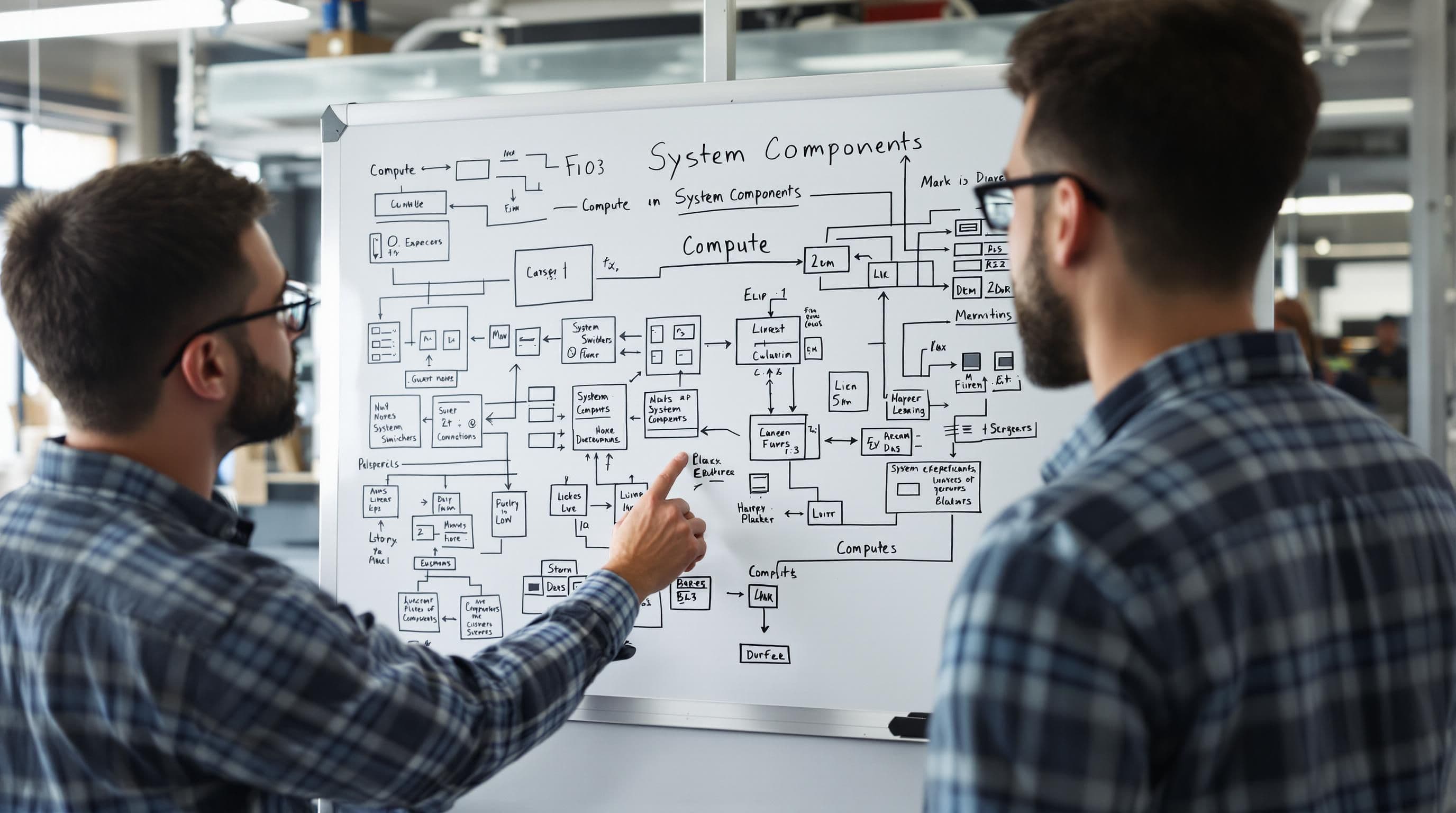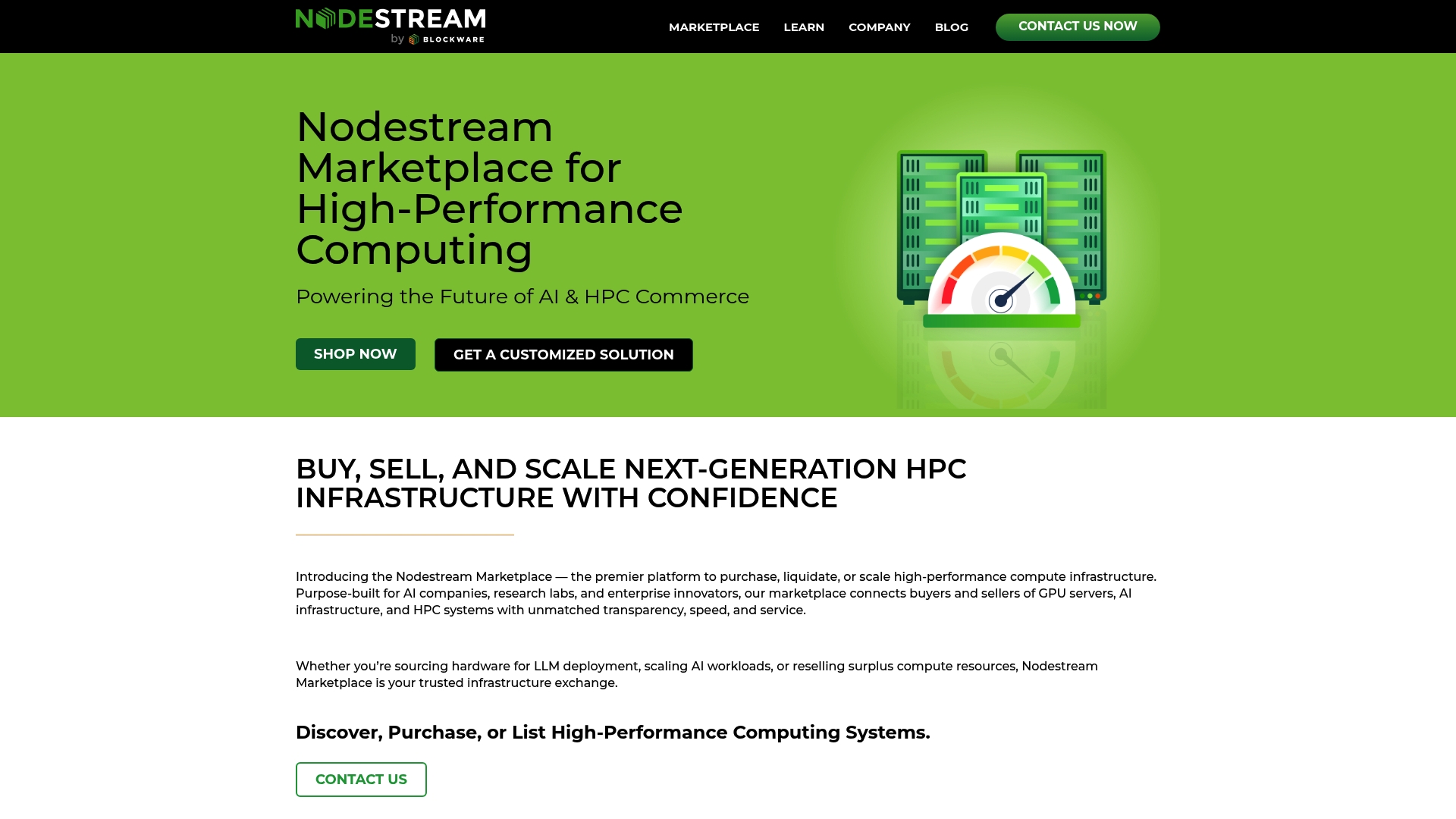Every giant leap in healthcare breakthroughs, weather forecasting, and AI model training has one thing in common: massive computational power. Think of this for a second. The fastest supercomputers in the world can now perform over one quintillion calculations per second. Most people believe the real story is about raw speed or huge processors. The real surprise is that the future of high performance computing is being shaped by energy efficiency, modular systems, and quantum hybrids that look nothing like yesterday’s supercomputers. Get ready to rethink what it means to solve the world’s hardest problems.
Table of Contents
- Understanding What HPC Means Today
- Key Components Of Modern HPC Systems
- Why AI And Enterprises Need HPC
- Top HPC Hardware Trends For 2025
Quick Summary
| Takeaway | Explanation |
|---|---|
| HPC drives innovation across industries | High Performance Computing facilitates breakthroughs in sectors like healthcare, engineering, and scientific research. Organizations leverage HPC for complex simulations and data analysis. |
| AI Model Training Requires HPC | Advanced AI algorithms demand immense computational resources, making HPC essential for fast, efficient model training with large datasets. |
| Energy Efficiency is Key for HPC Design | As computational needs grow, developing energy-efficient hardware ensures sustainable operation without sacrificing performance in HPC environments. |
| Hybrid Quantum-Classical Systems are Emerging | Integrating quantum computing with classical HPC allows tackling complex problems and enhances capabilities in various fields, spotlighting future innovations. |
| Modular HPC Will Improve Scalability | Future HPC designs emphasize modular architectures that enhance system flexibility and efficiency, meeting evolving computational demands. |
Understanding What HPC Means Today
High Performance Computing (HPC) represents a critical technological paradigm that enables complex computational tasks through advanced computational systems and specialized infrastructure. At its core, HPC involves aggregating computing power to solve intricate problems that traditional computing architectures cannot efficiently handle.

The Computational Powerhouse of Modern Technology
HPC has evolved from a niche technological solution to a fundamental infrastructure supporting breakthrough research, scientific discovery, and enterprise innovation. According to IBM, HPC relies on conventional computing bits and processors, differentiating it from emerging quantum computing technologies. These systems leverage interconnected high-performance processors, advanced memory architectures, and sophisticated networking technologies to process massive datasets and execute complex algorithms at unprecedented speeds.
The computational capabilities of HPC extend across multiple domains. In scientific research, HPC enables complex simulations of climate models, molecular dynamics, and astronomical phenomena. For enterprises, it provides the computational muscle to process big data analytics, machine learning models, and artificial intelligence training sets that would be impossible with standard computing infrastructure.
Industry Transformation Through Computational Scale
Research from Red Hat highlights the growing adoption of HPC across diverse industries, including healthcare, engineering, and scientific research. Modern HPC systems are not just about raw computational power but also about architectural flexibility. The integration of container technologies has revolutionized HPC, allowing organizations to deploy computational resources more efficiently and cost-effectively.
Enterprise adoption of HPC is driven by the need for real-time insights and competitive technological advantages. Whether it’s modeling complex financial market scenarios, designing advanced engineering prototypes, or training sophisticated AI models, HPC provides the computational infrastructure that transforms theoretical possibilities into tangible innovations.
The Future of Computational Problem Solving
As computational demands continue to escalate, HPC stands at the forefront of technological innovation. The systems are becoming more modular, energy-efficient, and capable of handling increasingly complex workloads. Machine learning, artificial intelligence, and data-intensive research are pushing the boundaries of what HPC can achieve, making it an indispensable tool for organizations seeking to leverage cutting-edge computational capabilities.
The trajectory of HPC indicates a future where computational power becomes more democratized, accessible, and integrated across various technological domains. Organizations that understand and invest in robust HPC infrastructure will be better positioned to drive technological innovation and solve increasingly complex computational challenges.
Key Components of Modern HPC Systems
Modern High Performance Computing (HPC) systems represent complex technological ecosystems composed of intricate hardware and software components designed to solve computational challenges at unprecedented scales. According to IBM, these systems are meticulously engineered to deliver exceptional computational performance across multiple interdependent domains.
Advanced Computational Infrastructure
HPC systems fundamentally rely on three critical architectural components: compute resources, networking infrastructure, and storage systems. Research from NetApp reveals that each component must operate at synchronized speeds to maintain optimal system performance. Compute resources typically include high-speed servers equipped with multi-core CPUs and powerful GPUs, capable of processing complex algorithms and massive datasets simultaneously.
The computational architecture integrates specialized processors designed for parallel processing. These include traditional CPUs, graphics processing units (GPUs), and field-programmable gate arrays (FPGAs) that can handle specific computational tasks with remarkable efficiency. The ability to distribute computational workloads across multiple processors enables HPC systems to tackle problems that would be impossible for traditional computing architectures.
Interconnectivity and Networking Capabilities
Intel’s research emphasizes that networking represents the critical nervous system of HPC infrastructure. High-bandwidth, low-latency interconnects ensure rapid communication between computational nodes, allowing complex distributed computing tasks to execute seamlessly. These networking technologies enable hundreds or thousands of servers to function as a unified computational platform, sharing data and processing tasks with minimal communication overhead.
Advanced networking technologies like InfiniBand and high-speed Ethernet facilitate direct, high-speed communication between computational nodes. These technologies support message passing interfaces (MPI) that allow different computational components to exchange information rapidly, creating a cohesive computational environment where complex problems can be solved through collaborative processing.
Storage and Data Management Systems
Storage systems in modern HPC environments are far more sophisticated than traditional data storage solutions. They must handle immense data volumes generated during complex computational tasks while providing rapid read and write capabilities. Parallel file systems and object storage technologies enable HPC systems to manage and process massive datasets efficiently.
These storage solutions are designed to support diverse workloads, from scientific simulations and machine learning model training to complex financial modeling and genomic research. The storage infrastructure must provide high-throughput access, ensuring that computational nodes can retrieve and store data quickly without creating bottlenecks in the processing pipeline.
The integration of these components creates a robust, flexible computational platform capable of addressing increasingly complex technological challenges. As computational demands continue to evolve, HPC systems will undoubtedly become more modular, efficient, and capable of handling unprecedented computational workloads across various domains.

Below is a summary table outlining the key hardware and software components of modern HPC systems and their primary roles:
| Component | Role in HPC Systems |
|---|---|
| Compute Resources (CPUs, GPUs, FPGAs) | Perform intensive computations and parallel processing |
| Networking Infrastructure | Provide high-bandwidth, low-latency communication between computational nodes |
| Storage Systems (Parallel/File/Object) | Store and manage massive datasets; enable fast read/write operations |
| Specialized Processors | Enable efficient execution of specific tasks (e.g., AI, machine learning, simulations) |
| Software & Middleware | Manage workloads, resource allocation, and enable scalable, flexible deployment (e.g., containers, MPI) |
Why AI and Enterprises Need HPC
The intersection of High Performance Computing (HPC) and artificial intelligence represents a transformative technological frontier where computational power meets advanced algorithmic capabilities. According to the National Science Foundation, HPC has become an essential infrastructure for enterprises seeking to leverage AI technologies at scale.
Enabling Advanced AI Model Training
AI model development requires unprecedented computational resources that traditional computing architectures cannot support. Research published in Frontiers in Artificial Intelligence reveals that HPC enables high-throughput AI training, allowing organizations to process petabyte-scale datasets with remarkable efficiency. Complex machine learning models, particularly in deep learning and neural network architectures, demand massive parallel processing capabilities that only HPC systems can provide.
Enterprises across industries are discovering that AI model training is not just about algorithmic sophistication but also computational scale. Genomic research, financial modeling, climate prediction, and autonomous vehicle development all require computational platforms that can simultaneously process massive datasets, run complex simulations, and generate actionable insights.
Accelerating Computational Complexity
The computational demands of modern AI applications extend far beyond traditional computing boundaries. Machine learning models increasingly require real-time processing of complex, multidimensional data streams. HPC infrastructure provides the necessary computational muscle to handle these intensive workloads, enabling enterprises to develop more sophisticated, accurate, and responsive AI solutions.
For instance, natural language processing models that power advanced chatbots and translation services require processing millions of parameters simultaneously. Similarly, computer vision algorithms used in medical imaging or autonomous driving demand computational platforms that can analyze intricate visual data with millisecond-level responsiveness. HPC systems make these technological innovations possible by providing the necessary computational density and parallel processing capabilities.
Strategic Competitive Advantage
Beyond technical capabilities, HPC represents a strategic competitive advantage for enterprises investing in AI technologies. Organizations that can process, analyze, and generate insights from massive datasets faster than their competitors gain significant market advantages. The ability to train more sophisticated AI models, reduce computational time, and explore more complex algorithmic approaches becomes a direct differentiator in technology-driven markets.
Moreover, HPC infrastructure allows enterprises to experiment with more ambitious AI projects that were previously considered computationally infeasible. From predicting complex economic trends to developing personalized medical treatments, HPC enables a new generation of AI-driven innovation that transcends traditional computational limitations.
As AI continues to evolve, the symbiotic relationship between high performance computing and artificial intelligence will only become more critical. Enterprises that recognize and invest in robust HPC infrastructure will be better positioned to lead technological innovation, solve complex computational challenges, and unlock unprecedented insights across various domains.
Top HPC Hardware Trends for 2025
The High Performance Computing (HPC) landscape is rapidly transforming, with emerging hardware technologies reshaping computational capabilities across industries. According to research from 2024, hardware innovation is driving unprecedented advancements in computational performance, energy efficiency, and computational diversity.
Heterogeneous Accelerator Architectures
Modern HPC systems are increasingly adopting heterogeneous computing architectures that combine multiple specialized processing units. A comprehensive survey of deep learning hardware accelerators reveals the critical role of diverse processing technologies such as GPUs, TPUs, FPGAs, and application-specific integrated circuits (ASICs). These specialized processors enable more efficient handling of complex computational tasks, particularly in artificial intelligence and machine learning applications.
The trend towards heterogeneous computing reflects a strategic approach to performance optimization. By integrating different types of processors, HPC systems can allocate computational workloads to the most appropriate hardware, maximizing energy efficiency and processing speed. This approach allows organizations to tackle increasingly complex computational challenges with greater flexibility and precision.
Energy Efficiency and Sustainable Computing
Research published in March 2025 emphasizes the growing importance of energy efficiency in HPC hardware design. As computational demands escalate, hardware manufacturers are developing innovative solutions that minimize energy consumption without compromising performance. Advanced processor architectures, intelligent cooling systems, and sophisticated energy management algorithms are becoming standard features in next-generation HPC infrastructure.
Sustainable computing is no longer an optional consideration but a critical design requirement. HPC systems are being engineered to reduce their carbon footprint while maintaining peak computational performance. This includes developing processors with lower power consumption, implementing dynamic power scaling technologies, and creating more efficient cooling mechanisms that reduce overall energy expenditure.
Quantum-Classical Hybrid Computing
One of the most exciting trends in HPC hardware is the integration of quantum computing resources into traditional computational ecosystems. A groundbreaking 2024 paper proposes a hardware-agnostic framework that augments classical HPC systems with quantum computational capabilities. This hybrid approach aims to unlock new computational possibilities in complex domains such as quantum chemistry, advanced optimization problems, and artificial intelligence research.
Quantum-classical hybrid systems represent a transformative approach to computational problem-solving. By combining the strengths of classical high-performance computing with the unique capabilities of quantum processing, researchers and enterprises can tackle computational challenges that were previously considered insurmountable. These systems promise to accelerate scientific discovery, enhance machine learning algorithms, and provide unprecedented insights across multiple disciplines.
As we move into 2025, the HPC hardware landscape continues to evolve at an unprecedented pace. The convergence of artificial intelligence, energy-efficient design, and quantum computing technologies is creating a new generation of computational infrastructure that promises to redefine the boundaries of technological innovation. Organizations that stay ahead of these hardware trends will be best positioned to leverage the most advanced computational capabilities available.
Here is a comparative table summarizing the top HPC hardware trends for 2025 and how each trend enhances computational environments:
| Trend | Description | Impact on HPC |
|---|---|---|
| Heterogeneous Accelerator Architectures | Integration of GPUs, TPUs, FPGAs, ASICs for specialized processing | Greater flexibility, speed, and optimization for various workloads |
| Energy Efficiency & Sustainable Computing | Focus on low-power chips, advanced cooling, intelligent power usage | Reduced operation costs, improved sustainability, lower emissions |
| Quantum-Classical Hybrid Computing | Combining quantum and classical resources in hybrid architectures | Solves previously intractable problems, accelerates AI & research |
Frequently Asked Questions
What is High Performance Computing (HPC)?
High Performance Computing (HPC) refers to the use of powerful computing resources and advanced architectures to perform complex computations that traditional computers cannot handle efficiently. It aggregates computing power to solve intricate problems across multiple domains.
Why is HPC important for AI model training?
HPC is crucial for AI model training because it provides the immense computational resources required to process large datasets and run complex algorithms. This allows organizations to develop and refine AI models more efficiently and accurately.
How does HPC contribute to energy efficiency in computing?
HPC contributes to energy efficiency by utilizing advanced hardware and software designs that optimize power consumption. Innovations such as low-power processors and intelligent cooling systems help minimize energy use while maintaining high performance.
What are the key trends in HPC for 2025?
Key trends in HPC for 2025 include heterogeneous accelerator architectures, a focus on energy-efficient computing, and the integration of quantum-classical hybrid systems, which collectively enhance computational capabilities and sustainability.
Ready to Turn HPC Challenges into Scalable Solutions?
If you are struggling to efficiently scale GPU servers or deploy AI-ready hardware fast enough to keep up with rapid advances in performance requirements, you are not alone. The article explained how modern demands like AI model training, massive data sets, and energy-efficient computing are making traditional procurement slow, risky, and uncertain for enterprises and researchers. Organizations cannot afford waste in hardware investment or downtime in AI workloads given the high stakes of HPC innovation. That is why a seamless infrastructure marketplace matters more than ever.

Take control of your next HPC build or liquidation. Explore our enterprise-grade marketplace for verified GPU and HPC equipment, with real-time inventory and support tailored for demanding AI and research needs. If you want bulk ordering and instant access to trusted HPC systems, visit Nodestream by Blockware Solutions today. Do not let slow procurement or unverified sources stop your next breakthrough. Buy, sell, and scale your HPC resources now to keep your business on the cutting edge.




